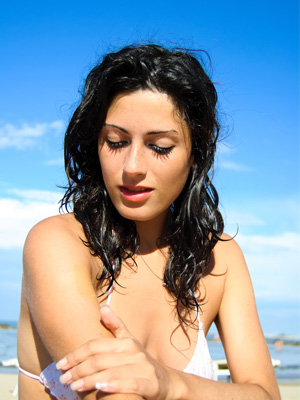If you’re anything like this writer, spending more than 10 minutes sans-SPF on a hot sunny day means you’re guaranteed about a week of aloe and tears as you promise never, ever to leave the house without Coppertone again. Of course, not everyone is vampiric. But while you may boast the complexion of sun-kissed surfer and anyone else with a resistance to the sun’s taunting glow, protection is necessary. So that’s why we’ve compiled this handy SPF go-to, so your days of sunburns and sun damage will be only a distant memory triggering bouts of tan-induced post-traumatic stress. (Writer’s note: I’m still haunted by my grade eight waterpark visit circa 1999.)
SPF
Sun protection factor “ or SPF “ should quickly become as routine as brushing your teeth or combing your hair, since UVA and UVB rays can lead to sun damage so extensive (yet so unnoticeable), that you’ll only understand the results upon discovering sunspots, freckles or moles. Dermatologists recommend a minimum of SPF 30 (which protects against 29 out of 30 parts UVB “ or 97%), with 4 or 5% zinc oxide (that also goes by ˜micronized zinc’), titanium oxide or avobenzone. That way, you’ll be given the maximum protection against the sun’s damaging components that can trigger aging, spots or cancer.
Application and reapplication
Regardless of what number SPF you choose (though dermatologists are quick to conclude that SPF 60 will not necessarily protect you against a lower SPF if used incorrectly), it’s crucial to apply sunscreen 20 minutes before heading outside, and to re-apply every two hours for maximum protection. While you may think that a lack of water activities or even a lack of sweat will increase sunscreen’s capabilities, its components are broken down over time, leaving you eventually exposed and in danger of sun damage.
Amount
While you may think that a concentrated amount of sunscreen is as effective as smearing a boatload all over yourself, dermatologists have proven that the more sunscreen you use, the more protection you’ll receive. (And no “ this isn’t a cash grab from sunscreen companies.) Applying a pea-sized amount of product will give you only a minimal filter, so while you may feel over-cautious using a good portion of product, you’re actually creating a thicker barrier between yourself and the sun.
Products
Despite what commercials or companies would have you believe, no type of sunscreen is superior to its counterparts. Meaning? Whether you use spray-on or cream, provided you’re applying it correctly, you’re still providing yourself with a level of protection that’s crucial in blocking out super-damaging UVA and UVB rays. It’s also imperative to match sunscreen to what you’re doing: playing tennis? Try a spray-on sports-oriented product that won’t dissipate as you sweat. Swimming? Opt for waterproof. Or simply very pale and afraid of colour when sipping an iced tea outside? Personally, this writer endorses anything for kids and fair-skinned babies.










